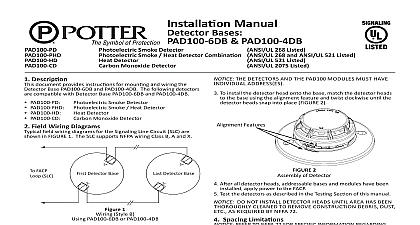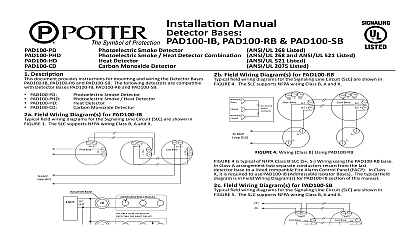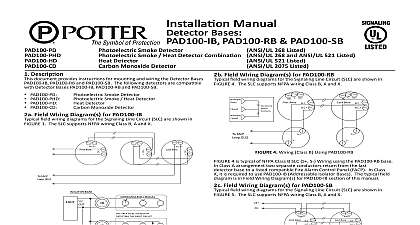Potter Detector Bases PAD100-LFSB, PAD100-SPKB

File Preview
Click below to download for free
Click below to download for free
File Data
| Name | potter-detector-bases-pad100-lfsb-pad100-spkb-7960431852.pdf |
|---|---|
| Type | |
| Size | 2.02 MB |
| Downloads |
Text Preview
550 0706 000 Bases PAD100 SPKB PAD100 PHD PAD200 PD PAD200 PHD and PAD100 CD Smoke Detector Description document provides instructions for mounting and wiring the detector bases and PAD100 SPKB The following detectors are compatible with detec bases PAD100 LFSB and PAD100 SPKB PAD200 PD PAD100 PD PAD200 PHD PAD100 PHD Photoelectric Smoke Heat Detector PAD100 HD PAD100 CD Field Wiring Diagram for PAD100 LFSB field wiring diagrams for the Signaling Line Circuit SLC FIGURE 1 The SLC NFPA wiring Class B A and X FIGURE 1 Typical of NFPA Class B SLC S S using the PAD100 LFSB base In Class A arrangement two separate conduc would return from the last detector base to a listed compatible Fire Alarm Panel FACP Detector Monoxide Detector PWR Base SLC PWR Base SLC FACP SLC 1 Wiring Class B Using PAD100 LFSB X Wiring FIGURE 2 requires use of PAD100 IM Addressable Isolator Module typical field diagram is in Field Wiring Diagram s for PAD100 IM The PAD100 IM can be obtained at www pottersignal com MODULE AREA TO BE ISOLATED BY THE SHORT CIRCUIT CIRCUIT IM NEXT TO A FACP SHALL BE INSTALLED 20 FEET FROM THE TERMINAL OF THE FACP 2 Wiring Class X Using PAD100 LFSB and PAD100 IM 3 PAD100 LFSB Wiring Field Wiring Diagram for PAD100 SPKB field wiring diagrams for the Signaling Line Circuit SLC FIGURE 4 The SLC NFPA wiring Class B A and X The PAD100 SPKB offer a choice of field power taps 1 8 1 4 1 2 1 2 and 4 watts FIGURE 5 for use with either 25 or 70.7 VRMs audio amplifiers The frequency range of the PAD100 SPKB is Hz The PAD100 SPKB is suitable for line supervision The PAD100 SPKB in DC blocking capacitor which allows for supervision voltage of either polarity 4 PAD100 SPKB Wiring Diagram power taps using nose pliers 5 PAD100 SPKB Wiring and Power Tap wiring SUPERVISION OF CONNECTION ensure proper installation of the detector head to the base wires shall be properly at the time of installation ARTICLE 300.3 B OF THE NATIONAL ELECTRICAL CODE NFPA 70 AS WELL ARTICLE 210 EQUIPMENT SHOULD BE INSTALLED IN ACCORDANCE WITH THE FIRE PROTECTION ASSOCIATION STANDARD 72 Wiring Instruction When using PAD100 SPKB PAD100 LFSB base observe the correct polarity of THE WIRING TO BE USED SHALL BE IN ACCORDANCE WITH THE PROVISIONS DO NOT USE LOOPED WIRE UNDER TERMINALS BREAK WIRE RUN TO Break wire runs to provide supervision for connections made to each wire pair When installing route field wiring away from sharp projections corners and components Base Mounting PAD100 SPKB should be mounted directly on the electrical box FIG 6a or to the LFSBBB W back box FIGURE 6b The PAD100 LFSB PAD100 SPKB holes are configured for a 4 x 2 1 8 deep square box Use a box for each and run the power circuit to all base locations 12 to 18 AWG conductors to connect to terminals of bases It is that the SLC conductors be color coded to avoid wiring errors and in system troubleshooting Improper SLC connections may prevent the system operating normally Disconnect power to the SLC until the detectors are Wire the detector bases according to Field Wiring Diagrams Use the dip switches SECTION 11 to set address es 1 127 for each detector THE PAD100 LFSB PAD100 SPKB OBTAINS THE ADDRESS FROM THE THE DETECTORS AND THE PAD100 MODULES MUST HAVE INDIVIDUAL To install the detector head onto the base match the detector heads to the using the alignment feature and twist clockwise until the detector heads into place FIGURE 6a HEAD Number 550 0706 the base the electrical box the provided screws screws are two for speaker the back box two for The non function screws will be in place by pressure fit of faceplate 6a Assembly of Detector on Electrical Box the base to LFSBBB W Back using the provided screws 6b Assembly of Detector on LFSBBB W Back Box power to the FACP After all detector heads addressable bases and modules have been installed Test the detectors as described in the Testing Section of this manual DO NOT INSTALL DETECTOR HEADS UNTIL AREA HAS BEEN THOROUGHLY TO REMOVE CONSTRUCTION DEBRIS DUST ETC AS REQUIRED BY NFPA Spacing Limitations REFER TO NFPA 72 FOR SPECIFIC INFORMATION REGARDING DETECTOR MOUNTING LOCATION AND SPECIAL APPLICATIONS PAD200 PD PAD100 PHD and PAD200 PHD Photoelectric Smoke PAD200 PD PAD100 PHD and PAD200 PHD are ANSI UL listed on 30ft spacing limitation with alarm set point from 135O 174O F on smooth Refer to NFPA 72 for specific information regarding detector spacing place and special applications Heat Detector ANSI UL listed spacing limitations of PAD100 HD smooth ceiling are dependent alarm set point Set Point of Rise Spacing Temperature Spacing to 174O F to 79O C to 185O F to 85O C to 160O F to 71O C 60 ft 60 ft 15 ft 15 ft 70 ft 70 ft Testing shall be performed periodically to determine if each detector operates Detectors will offer maximum performance when tested in compliance NFPA 72 REFER TO FIRE ALARM CONTROL PANEL FACP MANUAL FOR OF DIRTY VALUE READ PRINT ALARM SIMULATION AND WALK TEST Testing PAD100 PD PAD200 PD PAD100 PHD PAD200 PHD PAD100 HD and PAD100 are under normal conditions in standby mode the alarm indicator LEDs will pulse once every 4 seconds WHEN A PANEL IS CONFIGURED TO NOT FLASH LEDS THE LEDS ON THE WILL NOT FLASH AT ANY TIME Testing Value Read Print sensitivity drift value Dirty Value of the smoke detector can be checked at the The Dirty Value can be read and printed out at the FACP DETECTOR COMPENSATES SENSITIVITY UNTIL LIMIT OF WHEN COMPENSATION RATE REACHES LIMIT A TROUBLE SIG WILL BE INDICATED ON THE FACP Testing BE SURE TO DIS ENGAGE ALL ALARM SIGNAL SERVICES RELEASING AND EXTINGUISHING SYSTEMS PRIOR TO PERFORMING THE TEST EXCEPT AUTOMATIC TESTING BY THE FACP BE SURE TO THESE SYSTEMS WHEN ALL TESTING IS COMPLETE Test FACP must be placed into Walk Test Mode and follow the steps below Use the steps outlined below for the detector that is to be tested FAILURE TO ALARM DURING A TEST INDICATES A DEFECTIVE REPLACE DETECTOR IMMEDIATELY PAD100 PD PAD200 PD PAD100 PHD and PAD200 PHD Smoke Detectors a ANSI UL listed aerosol such as Home Safeguard Model 25S or SDi Smoke as acceptable to the Authority Having Jurisdiction AHJ PAD100 PHD PAD200 PHD and PAD100 HD Heat Detectors TAKE CARE DURING THE HEATING OF THE DETECTOR TO AVOID THE PLASTIC HOUSING Use of a low powered heat gun is acceptable Do not heat over 210oF 98.9oC Maintain a minimum of 1 foot between the detector and the heat gun will indicate with alarm when a sufficient amount of heat has been LED indicator will continuously flash while detector is in alarm Aerosol with Home Safeguard Model Versa Test Head VT1 or the SDI C6 Aerosol with SDI Solo 330 Dispenser as acceptable to the Authority Jurisdiction AHJ Heat the detector for a minimum of 10 seconds PAD100 CD Carbon Monoxide Detectors Use the Home Safeguard Model NEVER USE EXHAUST FROM VEHICLE TO TEST CO PORTION OF EXHAUST MAY CAUSE PERMANENT DAMAGE TO DETECTOR AND THE WARRANTY Maintenance detector should be cleaned as needed Detectors installed in environments prone to dust may need cleaning based on build up of dust The Dirty Value provides an indication when the detectors should be cleaned WATER WATER CAN AFFECT THE SENSOR CAUSING PERMANENT DO NOT SPRAY CLEANING CHEMICALS OR INSECT SPRAYS DIRECTLY ON NEAR THE DETECTOR DO NOT PAINT OVER THE DETECTOR DOING MAY CAUSE PERMANENT DAMAGE PAD100 PHD PAD200 PHD PAD100 HD and PAD


